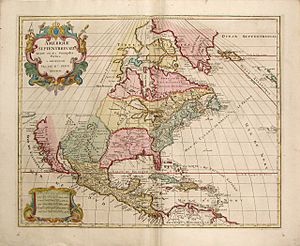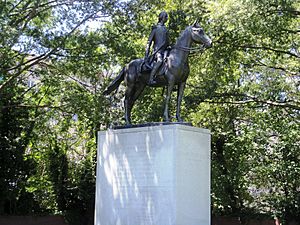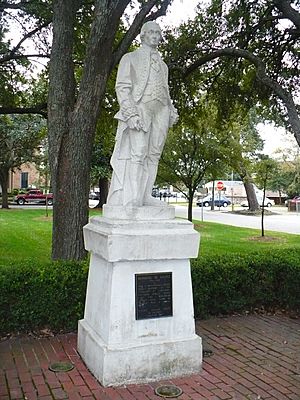Bernardo de Gálvez facts for kids
Quick facts for kids
The Most Excellent Field Marshal
Bernardo de Gálvez
|
|
|---|---|

Portrait by José Germán de Alfaro, 1785
|
|
| 49th Viceroy of New Spain | |
| In office 18 June 1785 – 30 November 1786 |
|
| Monarch | Charles III |
| Preceded by | Matías de Gálvez y Gallardo |
| Succeeded by | Alonso Núñez de Haro y Peralta |
| 5th Spanish Governor of Louisiana | |
| In office 1777–1783 |
|
| Monarch | Charles III |
| Preceded by | Luis de Unzaga |
| Succeeded by | Esteban Rodríguez Miró |
| Personal details | |
| Born |
Bernardo de Gálvez y Madrid
23 July 1746 Macharaviaya, Málaga, Crown of Castile, Spain |
| Died | 30 November 1786 (aged 40) Tacubaya District, Mexico City, New Spain |
| Awards | Order of Charles III |
| Signature |  |
| Military service | |
| Allegiance | |
| Branch/service | Spanish Army |
| Years of service | 1762–1786 |
| Rank | Captain General Marshal |
| Battles/wars | |
Bernardo Vicente de Gálvez y Madrid, 1st Count of Gálvez (born July 23, 1746 – died November 30, 1786) was an important Spanish military leader and government official. He served as the governor of Spanish Louisiana and Cuba. Later, he became the Viceroy of New Spain (which included much of modern-day Mexico and parts of the U.S.).
Gálvez started his military career at age 16. He fought in several wars across Europe, the Americas, and North Africa. As governor of Louisiana, he secretly helped the American colonists during the American Revolutionary War. He sent them important supplies and stopped British plans in the Gulf Coast area.
Gálvez won many battles. He famously captured West Florida from the British. This removed the British navy from the Gulf of Mexico. Because of his efforts, Florida was given back to Spain in the Treaty of Paris (1783). He even helped write parts of this treaty.
Gálvez's actions helped the American war effort. He became a hero in both Spain and the new United States. The U.S. Congress wanted to hang his portrait in the United States Capitol. This finally happened in 2014. Spain gave him many honors. In 1783, he became the viceroy of New Spain, taking over from his father. He served until he died from typhus.
Even though he is sometimes forgotten in the United States, many Americans still respect Gálvez. Especially in the southern and western states that were once part of Spanish North America. Pensacola celebrates Gálvez Day as a local holiday. Several places are named after him, like Galveston, Texas and Galvez, Louisiana. In 2014, Gálvez became one of only eight people to receive honorary U.S. citizenship.
Contents
Early Life and Military Training
Bernardo de Gálvez was born on July 23, 1746, in Macharaviaya, a small mountain village in Málaga, Spain. He studied military science at the Academia de Ávila. At age 16, he joined the Spanish invasion of Portugal. After this conflict, he was promoted to infantry lieutenant.
In 1769, he traveled to Mexico, which was then part of New Spain. As a captain, he fought against the Apache people with his Opata Indian allies. He was wounded many times. In 1770, he became the military commander of Nueva Vizcaya and Sonora, which were northern provinces of New Spain.

In 1772, Gálvez went back to Spain with his uncle, José de Gálvez. He then served in France for three years with an elite Franco-Spanish army unit. There, he learned to speak French. This skill would be very useful when he became governor of Louisiana. In 1775, Gálvez was seriously wounded during a Spanish attack on a fortress in Algiers. After that, he became a professor at the military academy of Ávila. He was promoted to lieutenant colonel and then to colonel in 1776.
Governor of Louisiana
On January 1, 1777, Bernardo de Gálvez became the new governor of Louisiana. This huge territory was once French but had been given to Spain in 1762. Spain received it after losing Florida to Britain in the Seven Years' War.
In November 1777, Gálvez married Marie Félicité de Saint-Maxent d'Estrehan. She was a Creole woman, meaning she was born in the colony but of French descent. This marriage helped Gálvez gain the support of the local Creole people. They had three children together.
As governor, Gálvez worked against British interests. He stopped British smuggling and encouraged trade with France. He helped George Washington's army get supplies during the American Revolutionary War. In 1779, he founded Galvez Town. He also promoted settlement in Nueva Iberia and allowed free trade with Cuba and Yucatán. Galvez Street in New Orleans is named after him. In 1779, Gálvez was promoted to brigadier.
Supporting the American Revolution
In December 1776, King Charles III of Spain decided to secretly help the United States. Spain did not officially join the war yet. In 1777, José de Gálvez, Bernardo's uncle, told Bernardo to make friends with the United States. On February 20, 1777, Spanish ministers in Madrid secretly told Gálvez to sell supplies to the Americans. The British had blocked American ports. So, the route from New Orleans up the Mississippi River was a good way to get supplies. Gálvez worked with Oliver Pollock, an American patriot. They shipped gunpowder, muskets, uniforms, and medicine to the American rebels.
Even before Spain joined the war, Gálvez helped the Americans. When an American group led by James Willing arrived in New Orleans with captured British ships, Gálvez refused to give them to the British. In 1779, Spanish forces led by Gálvez took West Florida from the British. Spain wanted to get back lands they had lost and remove the British threat.

On June 21, 1779, Spain officially declared war on Great Britain. A secret letter from King George III to General John Campbell in Pensacola ordered an attack on New Orleans. This letter, by chance, fell into Gálvez's hands. After reading it, Gálvez quickly prepared Louisiana for war.
Gálvez led a brilliant military campaign. He defeated the British at Fort Bute, Baton Rouge, and Natchez in 1779. The Battle of Baton Rouge on September 21, 1779, removed British forces from the lower Mississippi Valley. This protected New Orleans, the capital of Louisiana. In March 1780, he recaptured Mobile from the British at the Battle of Fort Charlotte.
Gálvez's most important victory was on May 8, 1781. He attacked and captured Pensacola, the British capital of West Florida. After losing Mobile and Pensacola, the British had no bases left along the Gulf Coast.
In 1782, forces under Gálvez's command captured the British naval base at Nassau in the Bahamas. Gálvez was upset that this operation happened without his direct orders.
Spain gave Gálvez many honors for his victories against the British. He was promoted to lieutenant general and field marshal. He became governor and captain general of Louisiana and Florida. He also received the titles of Viscount of Galveston and Count of Gálvez.
The American Revolutionary War ended while Gálvez was planning to attack Jamaica. From the American point of view, Gálvez's campaign stopped the British from surrounding the American rebels from the south. It also kept a vital supply route open. He gave the Americans supplies and soldiers, often through Oliver Pollock. For France and Spain, Gálvez's success led to Florida being returned to Spain in the Peace of Paris (1783). This treaty also recognized the independence of the former British colonies.
Viceroy of New Spain
In 1783, Bernardo de Gálvez was made a count. He was promoted to lieutenant-general of the army. He was also appointed governor and captain-general of Cuba. He received the titles Count of Gálvez and Viscount of Gálvez-Town on May 20, 1783. He returned to the Americas in October of the next year to start his new job. Soon after he arrived in Havana, his father, Matías de Gálvez y Gallardo, who was the viceroy of New Spain, died. Bernardo de Gálvez was chosen to take his place. He arrived in Vera Cruz on May 21, 1785. He formally entered Mexico City in June.
During his time as viceroy, two big problems happened. First, a severe freeze in September 1785 led to a famine in 1786. Second, a typhus epidemic killed 300,000 people that same year. During the famine, Gálvez used 12,000 pesos of his own money. He also raised 100,000 pesos from others to buy food for the people. He also started plans to grow more food in the future.
In 1785, Gálvez began building Chapultepec Castle. He also ordered the construction of cathedral towers. He had streets paved and streetlights installed in Mexico City. He continued work on the highway to Acapulco. He also worked to reduce the harsh treatment of Indian laborers on the project. He gave 16% of the money from lotteries and other games to charity.
Gálvez helped science in the colony. He supported the Royal Botanical Expedition to New Spain. This expedition of botanists and naturalists created a detailed catalog. This work, called Flora Mexicana, listed many different plants, birds, and fish found in New Spain.
Bernardo de Gálvez died on November 30, 1786, at age 40, in Tacubaya (now part of Mexico City). He was buried next to his father in San Fernando Church in Mexico City.
Gálvez wrote some important documents. One was Instrución para el Buen Gobierno de las Provincias Internas de la Nueva España (Instructions for Governing the Interior Provinces of New Spain, 1786). This document guided how these provinces were ruled until the end of the colonial period.
Legacy and Honors
Many places are named after Bernardo de Gálvez. These include Galveston, Texas, Galveston Bay, Galveston County, Galvez, Louisiana, and St. Bernard Parish, Louisiana. The Louisiana parishes of East Feliciana and West Feliciana are said to be named for his wife, Marie Felicite.
The Cabildo, a museum in New Orleans, has a portrait of General Gálvez. It also has information about his life. Spanish Plaza in New Orleans has a statue of Gálvez on horseback. There is also a Galvez Street in New Orleans. Mobile, Alabama, also has a Spanish Plaza with a statue of Gálvez.
In Baton Rouge, Louisiana, Galvez Plaza is next to City Hall. It is used for many city events. The 13-story Galvez Building is also part of the state government's office complex.
In 1911, the Hotel Galvez was built in Galveston and named after him. The street where the hotel is located is called Bernardo de Galvez Avenue.
On December 16, 2014, the United States Congress gave Gálvez honorary citizenship. They called him a "hero of the Revolutionary War." They noted he risked his life for American freedom. He provided supplies, information, and strong military support. In 2019, the Spanish Government placed a 32-inch-tall (81 cm) statue of Galvez in front of the Spanish Embassy in Washington, D.C.
Heraldry
- Heraldry of Bernardo de Gálvez
See also
 In Spanish: Bernardo de Gálvez para niños
In Spanish: Bernardo de Gálvez para niños
- Bernardo de Gálvez – the 1976 equestrian statue in Washington, D.C..
- Gálveztown (brig sloop) – a captured British ship renamed and used in the capture of Mobile (1780). A replica was built in Spain over 200 years later.
- Spain and the American Revolutionary War
- Matías de Gálvez y Gallardo, Bernardo's father
- José de Gálvez, Bernardo's uncle]






